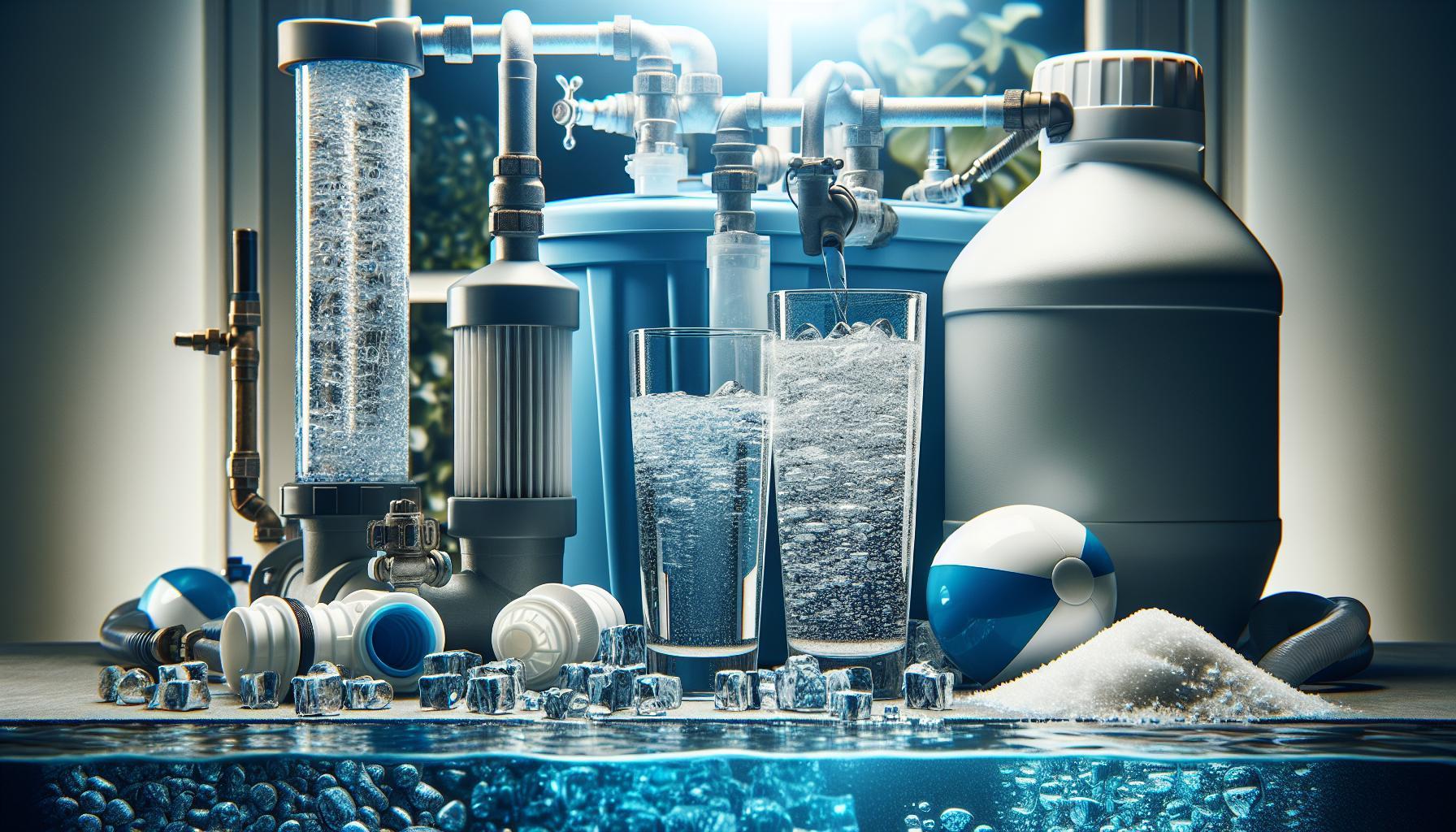As winter descends and icy pathways become a daily hazard, many wonder if they can repurpose common household items for safe ice management. One intriguing question is whether water softener salt is a viable option for melting ice. Exploring this alternative not only offers potential savings but also aids in environmentally-friendly winter maintenance.
Understanding Water Softener Salt: Composition and Uses
The effectiveness of water softener salt extends beyond just treating hard water—it can also function in various seasonal applications, such as ice melting. Understanding the composition of water softener salt is crucial for maximizing its utility, not only for home water systems but also for mitigating winter hazards. Most traditional water softener salts are primarily composed of sodium chloride (NaCl), a mineral that plays a central role in the water softening process by removing calcium and magnesium ions, which cause hardness in water.
Common Types of Water Softener Salt
There are several types of salt used in water softeners, each with distinct attributes and suitability for different applications:
- Sodium Chloride: The most common and cost-effective option, sodium chloride efficiently regenerates water softener resin and can also serve as a de-icing agent on roads and sidewalks.
- Potassium Chloride: Marketed as a low-sodium alternative, potassium chloride is more expensive and less effective than sodium chloride for both softening water and ice melting. It is favored by those monitoring their sodium intake.
- Magnesium Chloride: Though less common, magnesium chloride can be used in a pinch but is often less effective than the sodium counterpart for both applications.
For homeowners considering the use of water softener salt as an ice melt solution, it’s essential to be aware of these options, especially in light of effectiveness and environmental impact. Sodium chloride, in particular, can help safely melt ice on driveways and sidewalks, but care should be taken regarding its corrosive nature on pavement and vegetation.
Usage Considerations
While the question of “can water softener salt be used for ice melt?” opens up various considerations, practical usage should adhere to some best practices:
- Application Timing: For optimal results, apply the salt preemptively before heavy snowfall. This helps to break the bond between ice and pavement.
- Environmental Impact: Consider the potential effects on local flora and fauna. Regular use of sodium chloride can lead to soil and water salt buildup.
- Alternative Solutions: Explore eco-friendly alternatives like calcium magnesium acetate or sand for traction without the chemical side effects.
By understanding the composition and applications of water softener salt, individuals can make informed decisions that benefit their households year-round, including during the winter months when ice management becomes a pressing concern.
The Science Behind Ice Melt: How Do Different Salts Work?

Understanding the science behind ice melt reveals why different salts yield varying results on icy surfaces. The process of ice melting is a fascinating interplay of physical chemistry, where the melting point of ice is effectively lowered by the presence of salt. When salt is applied to snow or ice, it begins to dissolve in the thin layer of water that naturally exists on the surface. This dissolution process disrupts the equilibrium of water molecules, making it more challenging for water to remain in its solid state.
The Effectiveness of Various Salts
Different types of salts function through the same principle, yet they vary in effectiveness depending on temperature, concentration, and the conditions of application. Here’s a closer look at some common salts utilized for ice melt:
| Type of Salt | Melting Point Depression | Optimal Temperature Range | Environmental Impact |
|---|---|---|---|
| Rock Salt (Sodium Chloride) | -18°C (0°F) | 0°C to -10°C (32°F to 14°F) | Moderate |
| Calcium Chloride | -29°C (-20°F) | -18°C to -29°C (0°F to -20°F) | Higher |
| Magnesium Chloride | -21°C (-6°F) | 0°C to -15°C (32°F to 5°F) | Lower |
| Potassium Chloride | -15°C (5°F) | 0°C to -10°C (32°F to 14°F) | Moderate, less effective than others |
While water softener salt, typically composed primarily of sodium chloride, can indeed be an option for ice melt, its efficacy may not match that of other more specialized salts, especially under extremely low temperatures. Consider factors such as required melting temperatures and environmental impacts when selecting the appropriate material. For example, homeowners who are conscious of the ecological footprint may lean towards magnesium chloride, known for its lower toxicity to plants and animals.
Choosing the Right Salt for Ice Melt
When pondering, “Can water softener salt be used for ice melt? Safe winter solutions”, it’s crucial to assess not just the economic cost but also the melting efficiency and environmental considerations. If you reside in an area with heavy snowfall and consistently low temperatures, investing in calcium chloride or magnesium chloride may provide better results and reduce the risk of harming your landscape or local wildlife.
Ultimately, understanding different salts and their properties allows consumers to make informed choices that will yield effective results during winter conditions, ensuring safe passage across icy driveways and sidewalks while being mindful of their environmental footprint.
Comparing Water Softener Salt to Traditional Ice Melts

While many homeowners are familiar with traditional ice melts, water softener salt is an often-overlooked alternative that can also serve this purpose. Understanding the differences between these two products can lead to more effective and environmentally friendly winter maintenance. Water softener salt, primarily composed of sodium chloride, is commonly used to reduce hard water issues in homes. However, it can also melt ice, albeit with some caveats.
Effectiveness Comparison
When it comes to melting ice, traditional ice melts, such as those made from calcium chloride or magnesium chloride, generally outperform water softener salt. These products are specifically formulated for rapid ice melting at lower temperatures. For instance:
| Product Type | Melting Point | Speed of Action |
|---|---|---|
| Water Softener Salt | Above 20°F | Slower |
| Traditional Ice Melt (Calcium Chloride) | Down to -25°F | Rapid |
This table illustrates how traditional ice melts are designed for harsh winter conditions, whereas water softener salt is effective mainly in milder climates. If you encounter severe cold, wearing the right gear when clearing driveways is equally important as using effective melting agents.
Environmental Impact
Another critical factor is the environmental impact. Water softener salt tends to have a lower environmental footprint compared to some traditional ice melts, which can harm vegetation and aquatic ecosystems. Due to its nature, when water softener salt dissolves, it primarily increases the salinity of the water, which is generally less harmful in moderate amounts. If you are concerned about ecology, using water softener salt in small quantities for light ice conditions can be a viable solution.
Cost and Availability
In terms of accessibility, water softener salt is often more readily available in bulk and at a lower cost compared to specialized ice melts. Many households already have water softener salt on hand, making it a convenient option during unexpected snowfall. This cost-effectiveness can be appealing, especially when budgets are tight during winter.
Choosing between water softener salt and traditional ice melts ultimately depends on your specific needs—include safety, environment, and temperature conditions in your decision-making process. Conclusively, while water softener salt can serve as an ice melt in a pinch, relying on it exclusively in severe conditions might not yield the best results.
Safety Considerations: Is Water Softener Salt Safe for Your Driveway?
Using the right materials to manage ice on your driveway is crucial not just for safety, but also for the longevity of your concrete. Many homeowners wonder about the safety of using water softener salt as a de-icing agent during the winter months. While it can be effective at melting ice due to its sodium content, there are important safety considerations to bear in mind.
Potential Risks to Driveway and Landscaping
Water softener salt can be harsh on concrete surfaces if used excessively. Its high sodium levels may cause the concrete to deteriorate over time, leading to spalling and cracking. Additionally, when this salt washes off into nearby soil, it can harm plant life by altering the soil composition, ultimately affecting plant growth. It’s advisable to limit its use and consider alternatives that are less damaging to both your driveway and the environment.
Comparative Effectiveness and Alternatives
While water softener salt does have ice-melting properties, its effectiveness can vary depending on temperatures. Typically, it works best above 20°F (-6°C). For very low temperatures, safer and more effective alternatives include:
- Calcium chloride: It operates well in colder weather and is less harmful to concrete.
- Magnesium chloride: This is another eco-friendlier option, with a lower risk to plants and surfaces.
- Sand: While it doesn’t melt ice, it improves traction and poses no risk to driveways.
| Material | Melting Temperature | Environmental Safety | Concrete Safety |
|---|---|---|---|
| Water Softener Salt | Above 20°F | Moderate | Potential Damage |
| Calcium Chloride | Down to -25°F | Moderate | Less Damage |
| Magnesium Chloride | Down to -13°F | Higher Safety | Less Damage |
| Sand | N/A | High | No Damage |
In conclusion, while water softener salt can be used for ice melt, it’s important to consider its impact on your driveway and the environment. Employing safer alternatives can protect your surfaces and landscaping while still maintaining safety during icy conditions. Always weigh the pros and cons based on your specific situation and winter weather conditions.
Environmental Impact: Exploring the Effects of Salts on Landscaping
Though often overlooked, the impact of salts on landscaping can be profound, especially during the winter months when de-icing materials become essential. As property owners seek effective means to combat ice, many wonder about the implications of using materials like water softener salt for this purpose. While it may be tempting to utilize water softener salt due to its effectiveness, its environmental effects can pose significant risks to both landscaping and local ecosystems.
Salts, including those originally intended for water softening, can alter the soil chemistry and plant health when they leach into the ground. High salt concentrations can lead to <>soil degradation>, reducing its fertility and impacting the ability of plants to absorb essential nutrients and water. This phenomenon can cause plants to exhibit symptoms such as wilting, leaf scorch, and even chronic die-off if salt exposure is prolonged. Additionally, sensitive species may be particularly vulnerable, leading to a decline in biodiversity in affected areas.
Strategies for Safer De-Icing
To mitigate these adverse effects, property owners can adopt several environmentally friendly practices:
- Use Safer Alternatives: Instead of conventional salts, consider alternatives like magnesium chloride or calcium magnesium acetate. These options tend to be less harmful to plants.
- Limit Application: Apply de-icing agents judiciously. Excise anything beyond what is necessary to provide safe access.
- Plant Selection: Opt for salt-tolerant plants in areas where de-icing is frequent, minimizing damage to your landscaping.
- Barrier Strategies: Utilize barriers such as mulch or grass to reduce direct salt contact with plant roots.
Ultimately, while water softener salt provides immediate convenience in icy conditions, property owners must consider its long-term impact on their landscaping. Exploring safe winter solutions is essential, balancing both the need for effective ice management and the health of our ecosystems. By adopting smarter practices, you can ensure a safer environment for your plants while navigating the hazards of winter weather effectively.
Tips for Effective Ice Melting: Best Practices and Recommendations
As winter descends, icy sidewalks and driveways require immediate attention to ensure safety and accessibility. The right approach to ice melting not only prevents slips and falls but also protects your property from damage caused by harsh chemicals. With questions often arising, such as “Can water softener salt be used for ice melt?” it’s essential to understand the best practices and effective solutions to tackle the winter chill safely.
Understanding Ice Melt Options
When choosing a product for melting ice, it’s crucial to evaluate different options. While common alternatives include calcium chloride and magnesium chloride, water softener salt has garnered attention, leading many to ponder its viability. Here are key factors to consider before deciding:
- Effectiveness: Water softener salt may not melt ice as effectively as other solutions, particularly in extremely low temperatures.
- Environmental Impact: If you are concerned about the impact on plants and pets, look into eco-friendly options like rock salt or calcium magnesium acetate, which are less harmful.
- Surface Compatibility: Some melting agents can be damaging to concrete and asphalt, so check product compatibility before application.
Practical Application Techniques
Once you’ve selected your ice-melting agent, proper application is vital to maximize its effectiveness. Here are some practical techniques:
- Pre-treating: If you expect snow or ice, consider applying your chosen product in advance. This forms a protective barrier against ice buildup.
- Even Distribution: Use a spreader for even application, ensuring all areas are treated evenly to prevent localized ice patches.
- Quantity Control: Over-application not only wastes product but can also harm the ground and plants. Follow the recommended guidelines on the packaging.
Monitoring and Maintenance
Post-treatment care is just as crucial as application. Regularly check the treated areas for new ice formation. If necessary, reapply your ice melt before ice has a chance to bond with the surface. Here’s a simple table for reference on when to reapply based on varying weather conditions:
| Weather Condition | Recommended Reapplication Frequency |
|---|---|
| Light Snow | Every 2-3 hours |
| Heavy Snow or Sleet | Every 1-2 hours |
| After Rain Melting | Once after precipitation |
Incorporating these best practices into your winter ice management routine can enhance safety and effectiveness, ensuring you’re well-prepared for whatever the season throws your way. Remember, the question of “Can water softener salt be used for ice melt?” is only part of a larger conversation about safe winter solutions—choosing the right approach is key.
Alternative Solutions for Ice Management: Beyond Salt Options
When winter arrives, the shimmering blanket of snow may look beautiful, but it often conceals treacherous ice. Many people default to using traditional rock salt for ice management, but there are numerous alternative solutions that not only work effectively but also come with unique benefits. Exploring these alternatives can lead to safer walkways, less environmental impact, and cost-effective choices.
Eco-Friendly Alternatives
Switching from conventional salts can significantly reduce the harm caused to vegetation and local water systems. Here are a few sustainable options:
- Sand – Great for traction without melting ice, sand won’t harm plants or soil. It can be easily cleaned up once the snow melts.
- Beet Juice – This natural liquid can lower the freezing point of water, making it effective for ice melting while being less harmful to lawns.
- Vinegar – A homegrown solution, vinegar can be mixed with water to create a mild de-icer that prevents ice buildup, although effectiveness may vary.
- Coffee Grounds – By sprinkling used coffee grounds, you add traction and a bit of warmth to icy roads, helping to melt the frost.
Commercial Ice Melting Products
For those who prefer more specialized products, many companies offer commercial ice melt formulas that are effective and often pet-safe. Below is a summary of some popular options:
| Product Type | Active Ingredients | Effectiveness at Low Temperatures | Environmental Concerns |
|---|---|---|---|
| Calcium Chloride | Calcium chloride | Effective to -25°F | Minimal, but can harm plants |
| Magnesium Chloride | Magnesium chloride | Effective to -13°F | Less harmful to vegetation |
| Potassium Chloride | Potassium chloride | Effective to 25°F | Less effective; may harm plants |
| Urea | Urea or ammonia-based | Effective to 20°F | Can be used safely around plants |
Combining Solutions
Incorporating a blend of methods can optimize ice management strategies. For example, using sand for immediate traction while applying a liquid de-icer like beet juice or vinegar can help manage ice formation over time. This multi-faceted approach not only reduces reliance on traditional salts but also mitigates environmental impact—particularly important if you’ve ever wondered, “Can water softener salt be used for ice melt? Safe winter solutions,” and sought alternatives that have less adverse effects.
Consider experimenting with these alternatives this winter; not only will you help protect your environment, but you might also discover ingenious methods that make icy conditions safer and more manageable.
Maintaining Your Water Softener: What You Need to Know for Winter Use
When winter descends, homeowners often shift their focus to how to keep their properties safe from snow and ice. However, for those who use a water softener, winter requires extra attention to ensure these systems continue to operate efficiently. The frigid temperatures can affect the performance of your water softener and its salt levels, leading to potential issues if not monitored properly.
Understanding the Impact of Cold Weather
Cold weather can cause various problems for water softeners if they are not maintained correctly. For instance:
- Salt Crystallization: In extremely low temperatures, water softener salt can crystallize, making it difficult for the system to draw salt during regeneration cycles.
- Freezing Pipes: If your water softener is located in an unheated area, the risk of freezing pipes increases, potentially leading to leaks or system damage.
- Efficiency Drops: Colder water is less efficient at dissolving salt, which can hinder the ion exchange process necessary for water softening.
To mitigate these effects, consider wrapping exposed pipes with insulation and keeping your water softener in a temperature-controlled environment if possible.
Regular Maintenance Tasks
Maintaining your water softener throughout the winter months involves a few straightforward tasks. For optimal performance, follow these actionable steps:
- Check Salt Levels: Regularly inspect the salt levels in your brine tank. If the level drops below the recommended fill line, add salt to prevent inefficiency in softening.
- Use the Right Salt: Instead of considering whether water softener salt can be used for ice melt, opt for high-purity salt designed for softeners. Avoid using rock salt or other alternatives that may introduce impurities into the system.
- Schedule a System Check: If you notice any irregularities, schedule a professional servicing to ensure your water softener is functioning correctly.
By attending to these maintenance tasks, you help guarantee that your water softener will perform optimally throughout the winter season, effectively supplying softened water just when you need it most.
Knowing When to Seek Help
If you encounter persistent issues—even after performing regular maintenance—it may be time to consult a professional. Signs that you need expert assistance include:
| Symptom | Possible Cause | Recommended Action |
|---|---|---|
| Salt bridges or crusting on the salt surface | Dry air conditions or poor-quality salt | Dislodge the bridge and check the salt purity |
| Hard water symptoms (water spots, scaling) | Insufficient salt or system failure | Check salt levels and schedule service |
| Pipes freezing or leaking | Cold weather effects | Insulate pipes and inspect for leaks |
By taking these proactive measures and understanding your water softener’s needs during the winter months, you can ensure a reliable supply of softened water while avoiding the temptation to repurpose softener salt for ice melting. Keeping your system in excellent shape means you’ll be well-prepared for whatever winter weather comes your way.
Q&A
Can Water Softener Salt Be Used for Ice Melt?
No, water softener salt is not recommended for ice melt. While it may help in some instances, it can cause damage to concrete surfaces and is less effective than product specifically designed for ice melting.
Instead, consider using rock salt or magnesium chloride, which are safer and more effective options. Additionally, these specialized ice melts are formulated to work at lower temperatures than typical water softener salt, ensuring better results in winter conditions.
What is the difference between water softener salt and ice melt?
Water softener salt is primarily used to soften hard water, while ice melt products are formulated to lower the freezing point of water, making them effective in melting ice and snow.
Each product contains different chemicals and has varied effectiveness. Water softeners usually contain sodium chloride or potassium chloride, which can be corrosive. In contrast, ice melts may include calcium chloride, which is more effective in severe winter conditions.
Why does water softener salt cause damage to concrete?
Water softener salt can harm concrete because it promotes freeze-thaw cycles. When the salt dissolves, it creates a brine that penetrates into the concrete and freezes again, leading to cracking and spalling.
This is particularly concerning for driveways and sidewalks that are subjected to constant freeze-thaw cycles. Choosing appropriate alternatives such as calcium chloride can mitigate these issues, protecting your surfaces during winter.
Can I mix water softener salt with other ice melt products?
It’s not advisable to mix water softener salt with ice melt products. Doing so can create a less effective solution and could potentially lead to unwanted reactions or reduced effectiveness.
To ensure the best results, it’s recommended to use either one product or the other. For a comprehensive understanding of safe winter solutions, visit our article on winter care for your home.
What are safer alternatives to water softener salt for ice melting?
Safer alternatives to water softener salt include rock salt, calcium chloride, and magnesium chloride. These options effectively melt ice without causing damage to concrete.
Some environmentally friendly alternatives such as sand or sawdust can also provide traction on icy surfaces without causing chemical damage, making them a great choice when temperatures are milder.
How should I safely apply ice melt on my driveway?
To safely apply ice melt, spread it evenly over the icy area. Using a broadcast spreader can help achieve uniform distribution and minimize damage to your driveway.
Be cautious not to overapply, as excess can lead to runoff issues. For a smart and practical approach, refer to our guidelines on ice management during winter.
Is using water softener salt as ice melt eco-friendly?
Using water softener salt is generally not eco-friendly for ice melt applications. It can contaminate soil and runoff water due to its high sodium content.
For a more eco-friendly solution, consider using magnesium chloride or organic de-icing options, which are less harmful to plants and animals. These choices can be effective while helping to reduce environmental impact.
Insights and Conclusions
In summary, while it may seem tempting to use water softener salt as an ice melt solution, there are important considerations to keep in mind. Water softener salt is primarily designed to reduce hardness in water, and its effectiveness as an ice melter can vary. Using it on your walkways or driveways may not provide the results you want and could potentially lead to environmental concerns or damage to your concrete surfaces.
For safe winter solutions, it’s advisable to use products specifically formulated for ice melting, which are designed to work efficiently in lower temperatures without causing harm. Explore further into this topic to find the best methods for keeping your property safe and accessible during winter, ensuring that you are equipped with the right tools and information to tackle icy conditions confidently. For more insights and tips, stay engaged with our resources!






